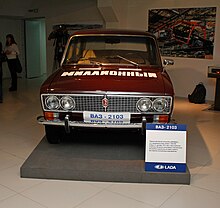| VAZ-2103 | |
|---|---|
 | |
| Overview | |
| Manufacturer | VAZ |
| Also called | |
| Production | 1972–1984 |
| Assembly | Togliatti, Samara Oblast, Russia |
| Body and chassis | |
| Class | Small family car |
| Body style | 4-door sedan |
| Layout | Front-engine, rear-wheel-drive |
| Related | |
| Powertrain | |
| Engine |
|
| Transmission | 4-speed Manual |
| Dimensions | |
| Wheelbase | 2,424 mm (95.4 in) |
| Length | 4,115 mm (162.0 in) |
| Width | 1,610 mm (63 in) |
| Height | 1,446 mm (56.9 in) |
| Kerb weight | 1,030 kg (2,271 lb) |
| Chronology | |
| Successor | VAZ-2106 VAZ-2107 |
The VAZ-2103 Zhiguli is a deluxe compact sedan car (small class, passenger car, model 3 in the Soviet classification), produced by VAZ, introduced in 1972 and produced until 1984. Better known by its export name Lada 1500 outside of its native Soviet Union and popularly nicknamed the Troika (Russian: Тройка, lit. 'three') in its domestic market. The car was developed jointly by VAZ and FIAT at the same time as Fiat 124 Special, and the two models had the same basis and influenced each other.[2][3] The 2103 was built under license and tailored to the Soviet and Eastern European markets. The 2103 externally differs from its predecessor, the VAZ-2101. Firstly, by its four, that is, double sets of headlights, different grille and direction pointers, moldings on the sides of the body and larger taillights. Its main difference - the more powerful 75 hp (55 kW) 1,452 cc (88.6 cu in) straight-four petrol engine.[4] In addition, this model is distinguished by the presence of a vacuum brake booster as well as self-adjusting rear brakes and internally on the new Fiat 125 based front panel. The interior was also more upmarket with a different steering wheel, cloth interior trim on export versions (in place of the VAZ-2101's vinyl) and an improved dashboard featuring wood imitation, tachometer, oil pressure gauge and front panel clock.[5]


- ^ a b c Lewis, Martin (1998), A-Z of Cars of the 1980s, p. 68
- ^ Ред. Маслов, Г.В.; Мирзоев, Г.К.; Котляров, В.А. Высокой мысли пламень. Управление главного конструктора АВТОВАЗ. Тольятти. Часть I. 2000 (Chronicle of AvtoVAZ with memoirs of its designers and engineers) (in Russian)
- ^ "Четыре глаза ВАЗа: история разработки ВАЗ-2103 (Four Eyes of VAZ: History of Development of VAZ-2103)". kolesa.ru. Kolesa magazine. Retrieved July 13, 2018.
- ^ Thompson, Andy. Cars of the Soviet Union (Haynes Publishing, Somerset, UK, 2008), p. 110.
- ^ Thompson, p. 111.